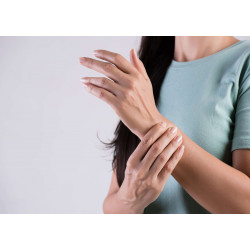DOCTOR INFORMATION
Elbow Examination (OSCE)
Introduction
- Greet the patient and introduce yourself
- Confirm patient details ✍
- Briefly explain the procedure to the patient
- Get patient consent ✅
- Wash hands ✋
- Ensure the upper limbs are exposed
- Check the patient is not in any pain
Look
Identify any clinically relevant signs:
💪 Muscle wastage: lower motor neuron lesion/ disuse atrophy
💪 Scars: prior surgery
Identify any object or equipment that may be clinically relevant:
💪 Prescriptions: current or recent medications indication 💊
💪 Aids/adaptations: support slings
Inspect the elbow/upper arm from the anterior aspect:
💪 Swelling: unilateral swelling
💪 Bruising: indicates prior surgery or trauma
💪 Scars: indicates prior surgery or trauma
💪 Carrying angle: 5-15° is normal 📐
💪 Cubitus valgus: >15° carrying angle due to trauma or congenital deformity 📐
💪 Cubitus varus: <5° carrying angle “gunstock deformity’ due to a supracondylar fracture of the humerus 📐
💪 Abnormal prominence of bones: due to fracture/dislocation
Inspect the elbow/upper arm from the lateral aspect:
💪 Muscle wastage: due to lower motor neuron lesion or disuse atrophy
💪 Scars: indicate prior surgery or trauma
💪 Fixed flexion deformity of the arm: caused by muscle spasticity or past joint trauma
Inspect the elbow/upper arm from the posterior aspect:
💪 Psoriatic plaques: scaly plaques with clear borders on the elbow joint, associated with psoriatic arthritis
💪 Scars: indicate prior surgery or trauma
💪 Rheumatoid nodules: firm lumps under the skin associated with rheumatoid arthritis
Feel
Assess the temperature:.jpg)
💪 Use the back of your hands to compare the temperature of the two elbows
💪 Raised temperature in conjunction with tenderness and swelling can indicate inflammatory or septic arthritis, or olecranon bursitis🌡
Palpate the elbow joint:
Assess for swelling, tenderness, or irregularity of the bone:
💪 Olecranon
💪 Radiocapitellar joint
💪 Medial epicondyle of the humerus
💪 Radial head
💪 Lateral epicondyle of the humerus
Palpate the biceps tendon:
💪 Assess for rupture or tendonitis:
- Ask the patient to flex their elbow to a 90° angle 📐
- Palpate over the elbow the crease to locate the tendon, assessing for any tenderness or a rupture
Move
Assess active (performed independently) movement:
💪 Active elbow flexion: bend elbows (normal = 0-145°) 📐
💪 Active elbow extension: straighten arms (normal =0°) 📐
💪 Active pronation: turn forearm so palm faces ground (normal =0-85°) 📐
💪 Active supination: turn forearm so palm faces ceiling (normal =0-90°) 📐
Assess passive movement:
💪 Controlled by you with the patient fully relaxed
💪 Assess for crepitus, restriction or discomfort
💪 Repeat the active movements passively 🔄
Special Tests
Medial epicondylitis “Golfer’s elbow” :
💪 Inflamed flexor tendons at insertion point due to injury caused by overload
💪 Ask the patient to actively flex their wrist against resistance to test for this:
- Patient should flex elbow to 90° 📐
- Stabilise elbow and firmly palpate medical epicondyle
- Use other hand to hold wrist
- Ask patient to form a fist and flex wrist while you apply resistance
💪 Pain over the medial epicondyle is a positive result
Lateral epicondylitis “Tennis elbow”:
💪 Inflames extensor tendons at insertion point due to injury caused by overload
💪 Ask the patient to actively extend their wrist against resistance to test for this:
- Patient should flex elbow to 90° 📐
- Stabilise elbow and firmly palpate lateral epicondyle
- Use other hand to hold wrist
- Ask patient to form a fist and extend wrist while you apply resistance
💪 Pain over the lateral epicondyle is a positive result ✅
Completion
- Tell the patient the examination is complete ✅
- Thank patient
- Wash hands ✋
- Summarise what the examination has revealed
Summary:
- Greet the patient and briefly explain the examination
- Inspect the patient to identify any clinically relevant signs
- Inspect the elbow from an anterior, lateral and posterior aspect
- Assess the temperature of the elbow
- Palpate the elbow and biceps tendon
- Assess the active and passive movement of the elbow
- Perform special tests for Medial epicondylitis and lateral epicondylitis
Related Articles
This step by step guide is designed to take you through the hand and wrist examination in OSCEs.
This step by step guide is designed to take you through the GALS examination in OSCEs.






-250x250.jpg)








